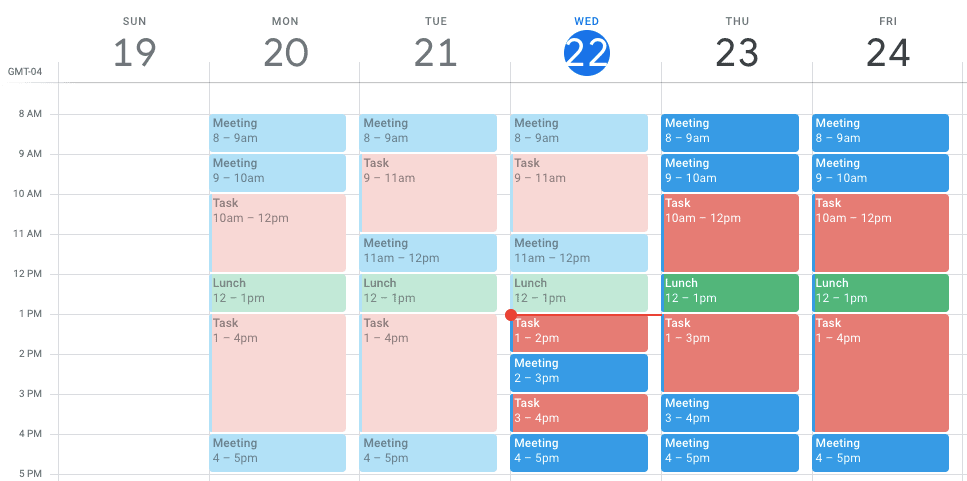At first glance, time blocking vs time boxing sounds like a needless comparison. But these two time management techniques take very different approaches to structuring your day. However, both methods can help you reclaim precious time.
- Time blocking allows you to map out your entire day, assigning specific blocks to different activities.
- Time boxing encourages you to tackle tasks within a set, allocated time.
Both methods encourage you to break your schedule into smaller chunks and focus on individual tasks to stay productive without burning out. But which method is the better fit for you?
Boost your team’s efficiency with Hubstaff's productivity tools
Understanding time blocking and time boxing
Time blocking and time boxing might sound like they’re cut from the same cloth, but they have distinct purposes — and powerful benefits.
What is time blocking?
Time blocking involves creating a structured schedule by setting aside dedicated time for particular tasks. Think of it as assigning appointments to your important tasks so they get the focus they deserve.
This method increases your awareness of how you use time. Because you know how long it takes to complete tasks, you become progressively more precise in planning your days.

What is time boxing?
Time boxing (or timeboxing) is a slightly different approach to managing your day. Instead of scheduling tasks into fixed blocks, this method limits your time on a particular task.
One of the main benefits of time boxing is how it pushes you to work more efficiently. Because you’re actively aware of the limited time you have for a task, you have to be productive. It forces you to think of smart ways to prioritize and complete important tasks.
With each time box, you build a rhythm. However, the biggest advantage of this method is that once you build momentum, it carries over into your following tasks.

Key differences between time blocking and time boxing
1. Focus on task duration vs. task scheduling
- Time blocking: Revolves around scheduling tasks for a specific time frame of your workday. This approach provides a broader view of your day, making it easier to organize multiple tasks and reduce cognitive load. Techniques like task batching can improve productivity further by grouping similar tasks into one block.
- Time boxing: Focuses on task duration. A specific amount of time is allotted for a task, which must be tackled within that fixed period. This encourages efficiency and helps you stay focused on completing the work within finite time limits. It’s particularly effective for deep work, forcing you to prioritize efficient outcomes over perfection.
2. Flexibility vs. rigidity
- Time blocking: Provides flexibility to adapt your structured schedule if priorities change, making it well-suited for dynamic work environments.
- Time boxing: Involves setting strict deadlines for individual tasks. Although it leaves little room for change, it’s highly effective at promoting discipline and preventing procrastination.
3. Work expansion vs. containment
- Time blocking: Accommodates work expansion within an allocated block, making it useful for larger, complex projects requiring longer periods.
- Time boxing: Parkinson’s Law states that work expands to fill the time available for completion. Time boxing prevents that by capping how long you spend on a task. This is also useful for building up and maintaining momentum.
Benefits of time blocking
Enhanced prioritization
Time blocking lets you allocate specific periods for your most important tasks so they don’t get lost in your busy day.
This reduces decision fatigue and lets you make clearer, faster choices about what to focus on.
Here are a few ways time blocking enhances prioritization:
- Aligns tasks with energy levels. Plan demanding tasks during peak energy hours and lighter ones during slower periods.
- Reduces cognitive load. Day theming and batching similar tasks help eliminate constant context switching.
- Helps create a clear roadmap. Dedicated time blocks provide a visual plan, making it easier to focus on priorities.
Since time blocking is a system built on predictability, it gives you a head start by allowing you to mentally prepare yourself for a task hours before you do it.
Improved focus and reduced multitasking
By blocking time, you allow yourself to focus on a single task at a time rather than juggling multiple activities.
Dedicating a fixed amount of time to specific tasks allows you to work without interruptions. This approach can also be used to break long tasks into manageable blocks, helping you stay on track without feeling overwhelmed.
Better work-life balance
Blocking time isn’t just for work — it’s for life, too.
Setting aside time for personal activities (and even unscheduled downtime) creates space for a balanced lifestyle.
As a result, you can avoid overcommitting, reduce stress, and steer clear of burnout. Who would say no to that?
Benefits of time boxing
Increased focus and efficiency
Time boxing’s fixed timeframes create a sense of urgency that helps you concentrate on a single task without getting sidetracked. Instead of letting work drag on, you allocate specific time slots and switch to a goal-oriented mindset.
With time boxing, you flip Parkinson’s Law on its head. With only a fixed amount of time, you’ll need to make every second count.
Less procrastination
Time boxing creates structured time slots for tasks, making it easier to start — even on projects you’ve been putting off.
The ticking clock builds urgency, reducing the tendency to procrastinate and keeping you accountable.
It’s particularly helpful for tackling overwhelming tasks by breaking them into smaller, manageable timeboxes with clear deadlines.
For example, dedicating 30 minutes to a challenging report can make starting far less intimidating. Pairing this approach with rewards, like a coffee break or some free time, keeps you motivated.
Better task estimation
Like time blocking, time boxing sharpens your ability to estimate how long tasks take.
Initially, you might find that you’re overloading one timebox or barely scratching the surface in another. But over time, you’ll dial it in, hitting that sweet spot between productivity and practicality.
The Pomodoro Technique, a popular time boxing method, builds on time boxing’s principles. It involves working in 25-minute intervals followed by short breaks to reward focus and limit fatigue.
How to implement time blocking

- Identify and prioritize tasks. Create a to-do list of all the tasks you need to complete. Prioritize by importance and urgency, putting critical activities first. A time management matrix is excellent for this purpose.
- Plan blocks of time for each activity. Allocate specific blocks of time for work, personal activities, and even small tasks like checking emails. Be realistic about the time spent on each task to avoid overloading your schedule.
- Use a digital or physical planner. Tools like Google Calendar let you make a visual commitment to your schedule so you always know where you are in the day.
- Incorporate breaks and downtime. Include short breaks to keep your mind fresh. Spending some time on leisure activities during break times also helps you recharge and refocus.
- Review and adjust as needed. At the end of each day, review unfinished tasks. Then, look for patterns. You might notice specific projects constantly maxing out time blocks or tasks that conclude only halfway through blocks. From there, you can tweak your time blocks for the following day.
How to implement time boxing
- Select suitable tasks. Identify tasks that tend to drag on, feel overwhelming, or are simply uninteresting to you. Time boxing works especially well for breaking down large projects or tackling these types of unpleasant tasks.
- Set goals and time limits. Define what you want to accomplish within each timebox. Then, choose a duration that fits the task. Smaller timeboxes of 15 to 30 minutes work well for quick tasks, while larger ones of up to 90 minutes can help with focused work.
- Use a timer and track your progress. Start the clock and commit to spending time on the task until the timer stops. Tools like a Pomodoro timer are great for managing these fixed periods. Check out our free online timer.
- Take breaks between sessions. After completing a timebox, take a short break to recharge. This helps maintain focus during longer work sessions and prevents burnout.
- Assess results. Evaluate how you used your time after each session. If personal commitments or unexpected changes disrupt your timeboxes, adjust your approach. Over time, you’ll refine your ability to balance different tasks and achieve better results.
Choosing the right method for you
Deciding between time blocking and time boxing comes down to your productivity style, tasks, goals, and even how your energy levels shift throughout the day.
Each method offers unique benefits, so combining them is the best way to improve productivity.
Evaluate your workflow
If you prefer a structured day where you allocate personal time and work tasks in advance, time blocking might suit you better. It helps you simplify decision-making by reducing the mental effort needed to figure out what to take on next.
On the other hand, time boxing works well for tasks that require a strict limit — especially when you’re trying to power through smaller, detailed tasks. However, this method may not go well with creative work, and it can require long periods of open-ended thinking.
Consider your energy patterns
Morning people often thrive with time blocking because they can plan their most demanding work during peak energy hours.
Time boxing, in contrast, allows you to adapt to highs and lows throughout the day by working within manageable time chunks.
Experiment and adapt
The best way to know which one is better for you is by trying both methods.
Use time blocking to create a structured day, then layer in time boxing for tasks that need extra focus or boundaries.
For instance, block out two hours for creative work and break it into several timeboxes to maintain momentum.
Don’t forget that while these two methods may thrive on rigidity, they are also iterative. Tweak your approach as needed to find what works best for you.
Tools to enhance time management
Implementing time blocking and time boxing becomes much smoother with the right software. Here are some tried-and-tested tools to get you started.
Google Calendar

A staple for structured day planning, Google Calendar lets you assign specific periods for each task and mark events as private to keep them personal. Or, share your calendar with team members so they know when you’re in focus mode.
Trello

Trello lets you organize lists to represent different time blocks, visualize deadlines, and track progress at a glance.
For time blocking, you can organize your lists by parts of the day — like “Morning Block,” “Afternoon Block,” and “Evening Block.” From there, you can allocate and track tasks within a structured schedule.
For time boxing, you can create task columns for specific time intervals, such as “15-minute Tasks” or “30-minute Tasks,” making it easy to assign strict time limits to each activity.
Hubstaff

Hubstaff helps you take time blocking or time boxing to the next level by tracking how much time you actually spend on tasks.
There’s also a calendar view that’s perfect for time blocking. Track time to specific tasks for a fixed period of time. Then, this data will be reviewed in the context of Hubstaff’s built-in activity metrics. Over time, this data can reveal which types of tasks you’re most productive with and where you tend to lose focus.
You can use Hubstaff’s timer app to enforce strict time limits for time boxing to help you log the exact duration spent on specific tasks. You can view timesheet data later to identify where you might need adjustments.
Any Pomodoro app
Many Pomodoro apps — even basic browser extensions — offer a straightforward way to start practicing time management without a full-featured tool.
This is a solid option if you don’t want to commit to a complex app or system but still want a practical way to stay on track throughout the day. It’s especially useful for those experimenting with time boxing and looking for an easy, no-pressure starting point.
Take control of your time, your way
There’s no truly superior option between time blocking and time boxing.
If there were such a thing as the “best time management technique of all time,” then there wouldn’t be more than one.
People work differently, and some time management methods work better for their specific use cases than others. In many cases, some time management methods used together become more than the sum of their parts. This is one of those cases.
An easy starting point is to block out time for specific projects throughout the day and then divide those blocks into smaller time boxes of related tasks. This is a great way to maximize both systems. Then, make adjustments based on your results.
Most popular
The Fundamentals of Employee Goal Setting
Employee goal setting is crucial for reaching broader business goals, but a lot of us struggle to know where to start. American...
Data-Driven Productivity with Hubstaff Insights: Webinar Recap
In our recent webinar, the product team provided a deep overview of the Hubstaff Insights add-on, a powerful productivity measurem...
The Critical Role of Employee Monitoring and Workplace Security
Why do we need employee monitoring and workplace security? Companies had to adapt fast when the world shifted to remote work...
15 Ways to Use AI in the Workforce
Whether through AI-powered project management, strategic planning, or simply automating simple admin work, we’ve seen a dramatic...



![How to Use Time Blocking to Make 2024 Your Most Productive Year Ever [Free Template]](https://hubstaff.com/blog/wp-content/uploads/2018/12/time-blocking@2x-780x390.png)
